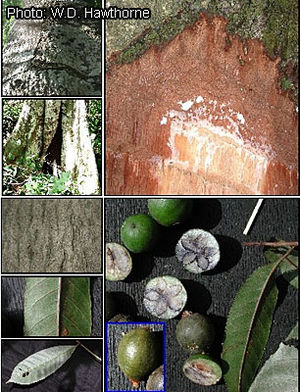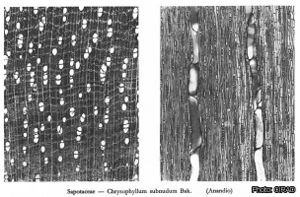Chrysophyllum subnudum (PROTA)
Introduction |
Chrysophyllum subnudum Baker
- Protologue: Oliv., Fl. trop. Afr. 3: 499 (1877).
- Family: Sapotaceae
- Chromosome number: 2n = 26
Synonyms
- Gambeya subnuda (Baker) Pierre (1891).
Vernacular names
- Adasema (En).
- Aninguéri argenté, longhi, longhi rouge (Fr).
Origin and geographic distribution
Chrysophyllum subnudum is widely distributed from Sierra Leone east to DR Congo.
Uses
The wood (trade name: longhi) is suitable for construction, flooring, interior trim, joinery, furniture, mine props, vehicle bodies, implements, panelling, veneer and plywood. In Gabon and Congo a bark decoction is used as purgative and for treatment of intestinal complaints. The sweetly acidulous fruit pulp is edible.
Production and international trade
The timber of Chrysophyllum subnudum is traded internationally in small amounts, but quantitative data are not available due to mixture with other Sapotaceae species.
Properties
The heartwood is yellow-grey to pinkish brown and indistinctly demarcated from the whitish sapwood, which is up to 10 cm wide. The grain is usually straight but sometimes wavy, texture fine. The wood is lustrous.
The wood is fairly heavy, with a density of 720–800 kg/m³ at 12% moisture content. It air dries well without difficulties. The rates of shrinkage are moderate to high, from green to oven dry 4.1–6.9% radial and 8.0–10.5% tangential.
At 12% moisture content, the modulus of rupture is 172–202 N/mm², modulus of elasticity 11,670–16,180 N/mm², compression parallel to grain 62–84 N/mm², shear 7.3–8.0 N/mm², cleavage 18–23 N/mm and Chalais-Meudon hardness 4.6–6.6. The wood is moderately shock-resistant.
The wood is fairly easy to saw, works well with hand and machine tools, and it can be planed to a smooth finish. It holds nails and screws well; pre-boring before nailing is recommended but not necessary. The wood takes polish and varnish well. It is only moderately durable and liable to attacks by blue stain, termites and marine borers. The sapwood is moderately resistant to preservatives, the heartwood resistant.
Description
- Medium-sized tree up to 25(–35) m tall; bole up to 60(–70) cm in diameter, straight and cylindrical, often shortly buttressed at base; bark surface greyish brown, smooth to fissured, inner bark fibrous, brown, exuding a sticky latex; young branches reddish brown hairy.
- Leaves arranged spirally, simple and entire; stipules absent; petiole 1–2 cm long, grooved above, greyish hairy; blade narrowly elliptical to oblong-lanceolate, 8–20 cm × 2.5–5 cm, cuneate at base, acuminate at apex, leathery, densely silvery grey velvety hairy beneath but glabrescent, pinnately veined with 8–12 pairs of lateral veins.
- Flowers in axillary fascicles, regular, 5-merous; pedicel 2–5 mm long; sepals free, broadly ovate, c. 2 mm long, reddish brown pubescent outside; corolla with c. 2.5 mm long tube and rounded lobes c. 1.5 mm long, ciliate at margins, greenish white; stamens inserted near base of corolla tube, opposite corolla lobes; ovary superior, conical to globose, long-hairy, 5-celled, style short.
- Fruit a globose berry c. 3 cm long, slightly 5-lobed, greenish to yellowish, glabrous, up to 5-seeded.
- Seeds ellipsoid, flattened, up to 2.5 cm × 1.5 cm, brown.
- Seedling with epigeal germination; hypocotyl 6–12 cm long, glabrous, epicotyl 0.5–3 cm long, pubescent; cotyledons ovate to elliptical, 3–5 cm × 2–3.5 cm, shortly stalked, leafy, glabrous.
Other botanical information
Chrysophyllum comprises about 70 species and occurs throughout the tropics. Tropical America is richest in species (about 45), followed by continental Africa (about 15), Madagascar (about 10) and tropical Asia and Australia (together 2). The genus has been subdivided into 6 sections, 2 of which (sect. Aneuchrysophyllum and sect. Donella) contain African species. Chrysophyllum subnudum belongs to sect. Aneuchrysophyllum.
In Côte d’Ivoire and Ghana Chrysophyllum subnudum flowers in December–June and fruits in November–February; in Gabon it flowers around August. The seeds are dispersed by animals that feed on the fruits such as elephants and possibly also chimpanzees.
Ecology
Chrysophyllum subnudum occurs in lowland semi-deciduous forest to evergreen forest, usually as an understorey tree, and is common in many regions.
Management
Chrysophyllum subnudum often regenerates abundantly, and seedlings are shade tolerant. The 1000-seed weight is about 770 g. Seeds start to germinate 2–8 weeks after sowing. The germination rate varies from 25% to 90%. The logs have to be treated on felling and the wood immediately after sawing. Fresh logs sink in water and cannot be transported by river.
Genetic resources
Chrysophyllum subnudum is not liable to genetic erosion because it is widespread and in many regions common.
Prospects
Very little is known about Chrysophyllum subnudum and research is needed to evaluate its usefulness as a timber tree on a wider scale. However, because of its small size in comparison with other Sapotaceae species, it seems of secondary interest only.
Major references
- Bolza, E. & Keating, W.G., 1972. African timbers: the properties, uses and characteristics of 700 species. Division of Building Research, CSIRO, Melbourne, Australia. 710 pp.
- Burkill, H.M., 2000. The useful plants of West Tropical Africa. 2nd Edition. Volume 5, Families S–Z, Addenda. Royal Botanic Gardens, Kew, Richmond, United Kingdom. 686 pp.
- de Koning, J., 1983. La forêt de Banco. Part 2: La Flore. Mededelingen Landbouwhogeschool Wageningen 83–1. Wageningen, Netherlands. 921 pp.
- Hawthorne, W.D., 1995. Ecological profiles of Ghanaian forest trees. Tropical Forestry Papers 29. Oxford Forestry Institute, Department of Plant Sciences, University of Oxford, United Kingdom. 345 pp.
- Takahashi, A., 1978. Compilation of data on the mechanical properties of foreign woods (part 3) Africa. Shimane University, Matsue, Japan, 248 pp.
Other references
- Aubréville, A., 1959. La flore forestière de la Côte d’Ivoire. Deuxième édition révisée. Tome troisième. Publication No 15. Centre Technique Forestier Tropical, Nogent-sur-Marne, France. 334 pp.
- Aubréville, A., 1961. Sapotacées. Flore du Gabon. Volume 1. Muséum National d’Histoire Naturelle, Paris, France. 162 pp.
- Aubréville, A., 1964. Sapotacées. Flore du Cameroun. Volume 2. Muséum National d’Histoire Naturelle, Paris, France. 143 pp.
- de la Mensbruge, G., 1966. La germination et les plantules des essences arborées de la forêt dense humide de la Côte d’Ivoire. Centre Technique Forestier Tropical, Nogent-sur-Marne, France. 389 pp.
- Durand, P., 1983. Aniégrés et longhis: étude comparative de leurs propriétés technologiques. Centre Technique Forestier Tropical, Abidjan, Côte d’Ivoire. 29 pp.
- Neuwinger, H.D., 2000. African traditional medicine: a dictionary of plant use and applications. Medpharm Scientific, Stuttgart, Germany. 589 pp.
- Oteng-Amoako, A.A. (Editor), 2006. 100 tropical African timber trees from Ghana: tree description and wood identification with notes on distribution, ecology, silviculture, ethnobotany and wood uses. 304 pp.
- Raponda-Walker, A. & Sillans, R., 1961. Les plantes utiles du Gabon. Paul Lechevalier, Paris, France. 614 pp.
Author(s)
- R.H.M.J. Lemmens, PROTA Network Office Europe, Wageningen University, P.O. Box 341, 6700 AH Wageningen, Netherlands
Correct citation of this article
Lemmens, R.H.M.J., 2007. Chrysophyllum subnudum Baker. In: Louppe, D., Oteng-Amoako, A.A. & Brink, M. (Editors). PROTA (Plant Resources of Tropical Africa / Ressources végétales de l’Afrique tropicale), Wageningen, Netherlands. Accessed 31 March 2025.
- See the Prota4U database.


